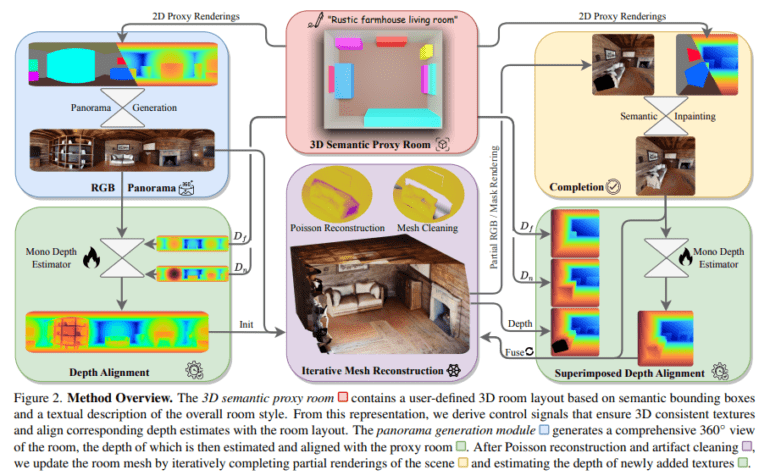TL;DR:
- ControlRoom3D, developed by Meta GenAI, redefines 3D room mesh generation for AR and VR applications.
- It introduces a 3D semantic proxy room concept, allowing users to outline room layouts using semantic bounding boxes.
- The method ensures diverse and realistic 3D meshes aligned with predefined layouts.
- Key components include guided panorama generation, geometry alignment, and mesh completion.
- ControlRoom3D outperforms existing methods in layout plausibility, completeness, and perceptual quality.
- Implications are significant for the AR/VR market, enabling enhanced user experiences and expanding application possibilities.
Main AI News:
In the ever-evolving landscape of augmented and virtual reality, the creation of lifelike 3D environments has long been a complex and daunting endeavor, often hampered by the intricacies of 3D modeling software. This challenge has hindered end-users from shaping their personalized virtual realms, a crucial aspect in a wide array of applications, from the realm of gaming to immersive educational simulations.
At the heart of this challenge lies the art of generating 3D room meshes that are not only intricately detailed but also exude a level of realism that seamlessly aligns with spatial logic. Unfortunately, contemporary automatic generation techniques frequently fall short in this regard, resulting in rooms that defy conventional spatial understanding with misplaced or repetitive objects. This quandary can be attributed primarily to the prevalent use of iterative inpainting strategies that focus on local contexts, often neglecting the importance of a global room layout and design perspective.
Enter ControlRoom3D, a groundbreaking innovation brought forth by the collaborative efforts of Meta GenAI, RWTH Aachen University, and the Technical University of Munich. This revolutionary AI method has redefined the landscape of 3D room mesh generation, offering a solution to the aforementioned limitations. At its core, ControlRoom3D introduces the concept of a 3D semantic proxy room, an ingenious approach that empowers users to outline a rough layout by defining semantic bounding boxes. This proxy room acts as a guiding framework, facilitating the creation of 3D meshes that not only exhibit diversity but also seamlessly harmonize with the predefined layout.
The hallmark of ControlRoom3D lies in its multifaceted approach, which amalgamates various technical components to produce coherent and credible room layouts. One such element is the guided panorama generation, a process that constructs a comprehensive 360-degree view of the room. This panoramic view plays a pivotal role in establishing a consistent style throughout the room, effectively mitigating the style drift issue often encountered in methods reliant on incremental inpainting.
Another pivotal aspect is the geometry alignment module, which harnesses the spatial dimensions of the 3D bounding boxes within the proxy room to align the generated 3D textures with the intended room layout. Through optimization of the depth predictions associated with these textures, ControlRoom3D ensures precise alignment of the final mesh with the proxy room’s geometry, thus preserving the plausibility of the room’s spatial arrangement.
The final step in ControlRoom3D’s methodology centers around mesh completion. Following the initial panorama generation and geometry alignment, the method shifts its focus toward refining the room mesh by filling in any missing areas. This task is accomplished through a fusion of inpainting techniques and depth alignment, seamlessly integrating new textures into the existing mesh structure. The outcome is a fully realized, high-resolution 3D room mesh that faithfully mirrors the user’s design vision while maintaining a high degree of structural completeness.
The effectiveness of ControlRoom3D is substantiated by its remarkable performance in generating plausible 3D room meshes. It excels in layout plausibility, structural completeness, and overall perceptual quality when compared to existing methods, as validated through extensive user evaluations and quantitative metrics. These findings underscore ControlRoom3D’s pioneering advancements in the realm of traditional room mesh generation methods.
Conclusion:
ControlRoom3D’s innovative approach to 3D room mesh generation addresses key limitations in the AR/VR market, paving the way for more immersive and realistic virtual environments. This advancement is poised to drive increased adoption of AR/VR technologies across various sectors, from gaming to education, offering users more control and enhancing their overall experience. As a result, the market can anticipate accelerated growth and broader utilization of these technologies in diverse applications.

